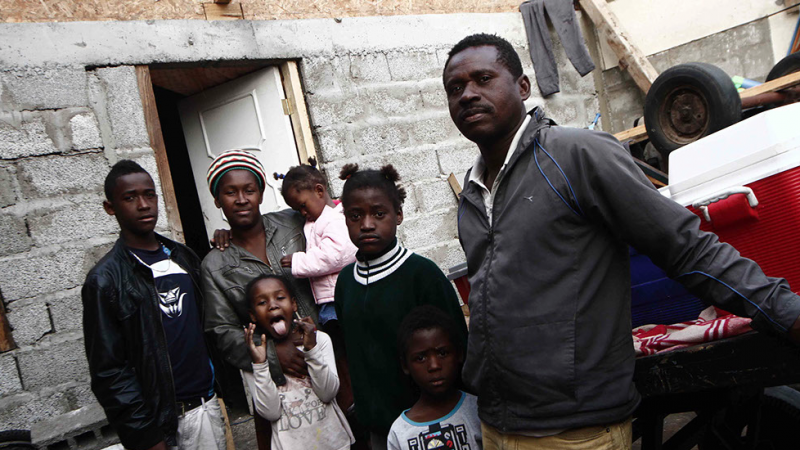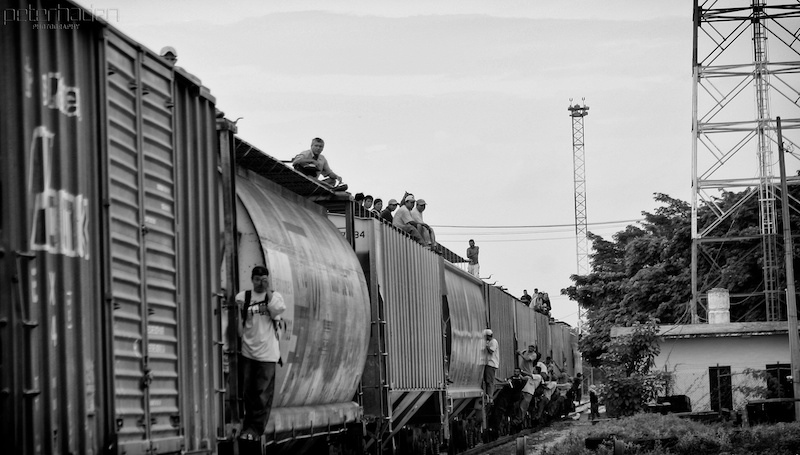
Many Colombians, like the Landázuri family (above), fled Colombia after being threatened. The Hangout focused on the route which thousands of Colombians take towards Antofagasta, in the north of Chile. Photo by Rodrigo Selles for CONNECTAS and Mercurio de Antofagasta.
Global Voices, in collaboration with CONNECTAS, Agenda Propia, Útero.pe, Vice and El Mercurio de Antofagasta, has begun a series of talks using Google Hangouts about the migration of Latin American communities towards other countries in the region entitled “The Challenges of Intra-American Migration”.
The first of these talks, focusing on the exodus of Colombian nationals to the Chilean city of Antofagasta, was held on March 13, 2015. These conversations included the statements of Colombian migrants in Chile, of experts on migration in the region and of journalists who closely follow the stories of those who move within the continent in search of better opportunities.
The discussion was moderated by Global Voices collaborator Robert Valencia. Other participants were Javier El-Hage from the Human Rights Foundation, Catalina Rojas and Jimena Araoz from Ciudadano Global – Jesuit Migrant and Refugee Service, and Cristian Asencio from El Mercurio de Antofagasta newspaper.
The complete Hangout (in Spanish) may be viewed in this YouTube video:
This virtual talk was inspired by the report “El Nuevo Éxodo Latino“ (The New Latin Exodus), which examines migration movements within the Latin American region and seeks to distinguish them from others which have already been investigated. Part of the Hangout accounted for the bases common to all migration movements and for the specific characteristics of different groups’ integration in the region. “We are all immigrants in the world”, said El-Hage. “The possibility of emigrating was not previously regulated nor prohibited.”
As an example of the numerous challenges of the migration experience, participants shared various contexts that showed how many have seen their routes modified by certain laws and their journeys marked by the violence which prevails in parts of the continent. Mexican journalist Priscila Hernández Flores presented part of this context in Mexico and Central America:
A partir del hallazgo de la fosa con 72 migrantes en Tamaulipas [en] modificó la ruta migratoria y los migrantes centroamericanos especialmente eligieron una ruta más larga, pero más segura (dentro de lo que cabe). Otro de los temas que tenemos que tomar en cuenta es el inicio del programa Frontera Sur que ha recrudecido el control de movimiento migratorio en carreteras o en tramos y específicamente han impedido que se suban al tren [también conocido como La Bestia]. Antes mirábamos las imágenes de un tren atiborrado con personas arriba sobre sus vagones […] Ahora es muy difícil que un migrante pueda subir a partir de los operativos de migración. Esto ha hecho que la ruta se haga caminando, y lo que antes se hacía en tres horas en un automóvil o en esos trayectos en el tren ahora se hace caminando, lo que ha generado otros riesgos para los migrantes.
Since the discovery of the graves of 72 migrants in Tamaulipas, the migratory route has changed and Central American migrants especially have chosen a longer, but (relatively) safer route. Another issue which must be taken into account is the commencement of the Southern Border programme which has intensified controls on migration movements on motorways or on routes and more specifically has prevented migrants from boarding the train [also known as La Bestia (The Beast)]. In the past we saw images of a packed train with people on top of its wagons […] Now it is very difficult for a migrant to board since these migration operations began. This has meant that the route is undertaken on foot, and what was previously covered in three hours in a car or on those train journeys is now done on foot, which creates other risks for the migrants.
The Hangout also presented the stories of two Colombian immigrants in Antofagasta, who addressed the advantages and difficulties of changing country and starting again. One of them emphasised that beyond his problems finding work in Buenaventura, the city which he had left, the primary obstacle was violence. The stories also exposed the difficulties of entering Chile due to prejudice towards Colombians, who have seen their image harmed as a result of problems involving other migrants from Colombia: “for one, we all pay”.

Central American migrants board the train known as “The Beast”, in Mexico. Photo by Peter Haden, published under Creative Commons licence.
Cristian Asencio, who was responsible for collecting these statements, explained that when he was trying to research his report the migrants seemed somewhat evasive:
Hay cierta desconfianza producto de que algunos programas noticiosos han sido despectivos con la inmigración [Estos programas] se enfocan en la criminalización del migrante y verlo como el sospechoso de siempre.
There is a degree of mistrust owing to the fact that some news programmes have been contemptuous of immigration. [These programmes] focus on the criminalisation of migrants and view them as the typical suspects.
Catalina Rojas, from Ciudadano Global, explained that when they began their work two years ago in Antofagasta, these issues “were little known”. Her colleague Jimena Araos added that there have been attempts to improve institutionality, but that it has been a difficult task:
Es una estructura enorme. Estamos hablando desde la oficina de migración hasta el sistema de salud que tiene que hacer cambios para que los migrantes puedan ser acogidos. Hay voluntad pero [queda] mucho por hacer.
It's an enormous structure. We're talking about changes which need to be made from the migration office to the health system so that migrants may be welcomed. The will to change is there, but [there's still] a lot to be done.
As our countries unite by means of economic blocs such as the Pacific Alliance, new challenges arise as a result of policies which gradually seek to allow the free movement of people across borders. For this reason, the participants agreed that in the case of Chile there is a certain resistance to opening borders:
Probablemente en la población hay renuencia en abrir sus fronteras […] Pasa algo curioso [y es que] el dinero corre sin fronteras pero no las personas. Se supone que esta Alianza del Pacífico permite el desplazamiento de personas pero en la práctica no ocurre así.
Most likely there is reluctance among the population to open the country's borders […] Something strange is happening [in that] money flows across borders but not people. The Pacific Alliance is supposed to allow the movement of people but in practice this is not the case.
Laws are not the only solution
Part of the conclusions addressed certain alternatives. Asencio and Araos agreed on the need to work on laws, but also to go further. Raising awareness and education work is necessary in order to establish responsible dialogues with the media:
…a veces no solamente las leyes son fundamentales, deben existir cambios culturales y esto sólo se da con educación […] es importante la forma en la que se presenta el inmigrante ante la prensa, y principalmente es necesario trabajar con los actores involucrados.
…sometimes it is not only the laws which are fundamental, but cultural changes must also take place and this can only happen with education […] the way in which immigrants are represented in the press is important, and primarily it is necessary to work with the people involved.
Rojas considers it necessary “to create meeting spaces where immigrants and natives can get to know one another” to promote integration. Finally, El-Hage affirmed that processes of integration cannot only apply to the exchange of goods. “People must decide where they wish to work according to supply and demand”, he said, adding that in any model, the primary focus must be on human rights, since the reasons leading workers to migrate can go far beyond the economic. Migration may also be impelled by family, cultural or personal security reasons.
For more information or to ask questions, head to the Twitter accounts of Global Voices (@gvamericalatina) and CONNECTAS (@ConnectasOrg). The discussion will also be collated using the hashtag #HangoutCONNECTAS. In this way, people may not only ask questions but also make suggestions for future discussions on Latin American migration within the region.







3 comments